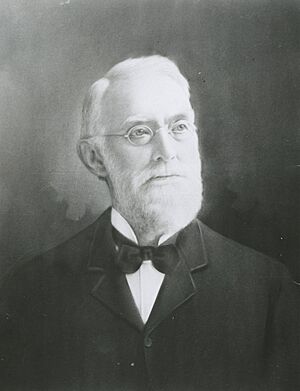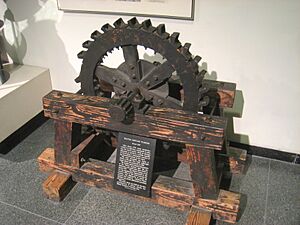Lester Allan Pelton facts for kids
Quick facts for kids
Lester Allen Pelton
|
|
|---|---|

Pelton, c. 1880
|
|
| Born | September 5, 1829 Vermillion, Ohio, U.S.
|
| Died | March 14, 1908 (aged 78) Oakland, California, U.S.
|
| Occupation | Inventor |
| Awards | Elliott Cresson Medal (1895) |
Lester Allan Pelton (born September 5, 1829 – died March 14, 1908) was an American inventor. He played a big part in creating hydroelectricity and hydropower. This means using the power of moving water to make electricity. He helped develop this technology in the American Old West and around the world.
In the late 1870s, Pelton invented the Pelton water wheel. This was a special type of water turbine that was very good at using water's energy. It was the most efficient design of its kind back then. People see him as one of the key figures in hydroelectric power. He even received an award called the Elliott Cresson Medal and is in the National Inventors Hall of Fame.
Contents
Lester Pelton's Early Life
Lester A. Pelton was born in a log cabin in a rural area of Vermilion Township, Ohio. His family moved to Ohio after his grandfather, Captain Josiah Pelton, lost money during the War of 1812. Lester's parents were Allen Pelton and Fanny Cuddeback.
As a young boy, Lester worked on his family's farm. He likely went to a local school nearby. In 1850, when he was older, Pelton moved from Ohio to California. He joined many others hoping to find gold during the California gold rush.
He didn't find much gold, but he found other ways to make a living. He fished in the Sacramento River and sold his fish. He also worked with wood, doing jobs like wood-milling and carpentry. In 1860, he moved to Camptonville, near the Sierra Nevada mountains. Here, he worked as a millwright and carpenter. A millwright builds and repairs mills and machinery. Pelton spent a lot of time reading and watching how mining worked. His jobs and studies taught him a lot about mining equipment and engineering.
Inventing the Pelton Wheel
Pelton got his ideas for improving water wheels by studying mining equipment. He saw how things worked in California's gold rush areas. Before his invention, steam power was used a lot in mining. But it needed a lot of wood for fuel, which led to forests being cut down. Water wheels were also used, but they weren't very good at turning the energy of mountain streams into power.
One day in the 1870s, Pelton saw something interesting by accident. He was watching a water turbine spin. A part holding the wheel slipped, making it hit the water jet in a different spot. Instead of the water hitting the middle of the cups, it hit near the edge. This made the water flow in a half-circle and come out in the opposite direction. Surprisingly, the turbine started moving faster! This was Pelton's big discovery. In other turbines, water hitting the middle of the cup caused a lot of wasted energy.
Pelton experimented and built models to make his design better. He improved on an older design called the Knight wheel. The Knight wheel had a single cup that received the water jet slightly off-center. Pelton's wheel used a split double cup. This meant it had two cups side-by-side. The water jet hit directly onto the common part between the two cups. This design captured the water's energy much more efficiently.
Pelton's design brought a new scientific idea to hydropower. It introduced the impulse turbine, which uses the force of a fast-moving water jet. Most older water turbines were reaction machines, powered by water pressure. Pelton's wheel was perfect for places with high head, meaning a big drop in elevation for the water. This allowed it to use the kinetic energy of a small, fast mountain stream.
Building and Using the Pelton Wheel
In the late 1870s, Pelton built and tested his first turbine wheel. He called the special blades the Pelton Runner. He made these at the Miners Foundry in Nevada City, California. In 1878, he put the first working Pelton wheel in the Mayflower Mine in Nevada City.
At that time, the Knight Foundry wheel was considered the best. But in 1883, a competition was held at the Idaho Mine in Grass Valley. Pelton's design proved to be much better. The Pelton wheel could turn 90 percent of the water's energy into power. The next best competitor only reached less than 77 percent. Most old water wheels were less than 40 percent efficient.
The Pelton wheel also worked well even when mountain streams had low water flow. In 1887, a miner connected Pelton's wheel to a dynamo. This created the first hydroelectric power in the Sierra Nevada mountains.
In 1895, one of the biggest Pelton wheels of his time was installed. It was at the North Star Mine Powerhouse in Grass Valley, California. An engineer named Arthur De Wint Foote designed and installed a huge wheel, 30 feet across. It worked very well, providing much more hydropower to create compressed air for mining.
Pelton received a patent for his wheel and its unique double-cup design. In 1888, he started the Pelton Water Wheel Company in San Francisco. This company helped meet the growing need for hydropower and hydroelectricity across the West and worldwide. While 'Pelton' is a brand name, the term is often used for any similar impulse turbines.
Lester Pelton's Legacy and Awards
Lester Pelton passed away in California at 78 years old. He is buried in his family's cemetery in Vermilion, Ohio. His Pelton Runner design is still used today to make hydroelectric power in the United States and around the world. Later designs, like the Turgo turbine and the Banki turbine, were inspired by his invention.
In 1895, The Franklin Institute in Philadelphia, Pennsylvania, gave Lester Pelton the Elliott Cresson Medal. This award is now called the Benjamin Franklin Medal. It recognized his amazing inventions in technology. In 2006, he was added to the National Inventors Hall of Fame.
There are memorials and monuments honoring Pelton and his Pelton Runner in several places. You can find them in Camptonville, California, at the Miners Foundry in Nevada City, and at the Smithsonian Museum in Washington D.C.. There's also one at the California Resort at Disneyland in Anaheim.
See Also




